PDF of this article (350 KB)
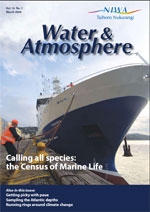
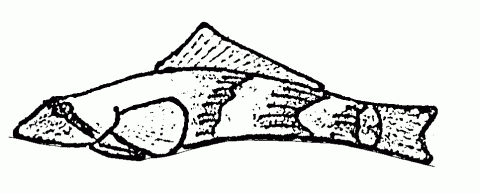
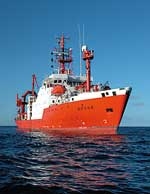
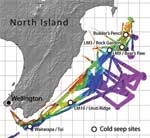
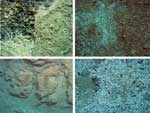

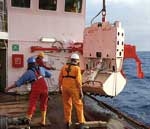
Kerstin Kröger and David Bowden have been to sea for a closer look at what’s bubbling up from below.
Methane (natural gas) comes out of bogs, sheep, cows, and cookers, right? Strange then that NIWA and co-researchers have recently been searching for it a thousand metres down on the seabed of the Hikurangi Margin off New Zealand’s east coast.
From January to March 2007, a multinational crew of research scientists aboard the German research vessel Sonne studied Hikurangi Margin ‘cold seeps’, where methane emerges from the seabed. Many of these sites were first discovered the previous year by NIWA and US scientists using circumstantial data from fishermen compiled in the 1990s by NIWA and Te Papa. The three legs of Sonne voyage SO191 enabled much more detailed investigations of the sites. For their part in the New Vents voyages, NIWA scientists worked on broad-scale geophysical surveys of the area, remote camera deployments, and biological sampling of seep sites.
Work at sea
Following seismic and multibeam surveys of the area, the team used side-scan sonar, towed cameras, and an ROV (remotely operated vehicle) to create accurate maps of the seep sites. Then TV-guided equipment, including a massive benthic (seafloor) grab, was used for precise sampling of minerals and biology. The Sonne’s live-camera capability on these tools puts an end to the usual ‘fishing in the dark’ when taking samples from many hundreds of metres below the ship. This is especially important on cold seep sites, which may be only a few metres across. Seabed signs of seeps include white bacterial mats, patches ofblack anoxic sediment with a characteristic ‘raindrop’ texture caused by an unidentified species of polychaete worm from the Ampharetidae family, empty white shells of the seep clam Calyptogena sp., and dense populations of bizarre Siboglinid tube worms that live only at seeps and hydrothermal vents.
Back on shore
The overall goals of the multinational New Vents programme are to describe the geological setting in which seeps occur, to quantify the flux of methane through the seafloor, and to understand the bio-geochemical processes that maintain the distinctive biological communities of the seep sites. Post-voyageanalyses are now underway in several institutes around the world, with NIWA scientists working on geological data from seismic surveys and on the identification of animals recovered from the seeps. When results from all these analyses are combined, we will have a much more comprehensive picture of where cold seeps occur on the Hikurangi Margin, how they form, the processes that govern energy flow through them, and the feeding relationships, diversity, and evolutionary history of organisms that live in them.
What’s methane doing on the seabed?
Whether it comes from a bog (or a sheep, or a cow), or from the bottom of the sea, methane is formed through the decay of organic matter. The Hikurangi Margin is a subduction zone where the Pacific tectonic plate slides underneath the Australian plate. This causes organic material(mud) on the Pacific seafloor to be taken deep underground where it breaks down into simpler organic molecules, including methane.
Being the lightest hydrocarbon, methane tends to move upwards through fault zones, fractures, and soft sediments, and in some places it reaches the seabed. At low temperature and high pressure (below about 1000 m depth around New Zealand), methane becomes trapped as a frozen layer of methane hydrate just below the seabed. In some places, however, free methane reaches the seabed and this is where things get interesting from a biological perspective.
In the presence of sulphate ions from seawater, some microbes are able to oxidise methane, thereby releasing energy which they use to build essential organic compounds. These microbes are anaerobic and live buried in the sediment, but the main by-products of their activities – carbonate and sulphide ions – are very apparent on the seabed above.
The carbonate ions actually form rock which can build up into conspicuous reef structures known as chemoherms. The sulphides, toxic to most life, are a food source for another group of bacteria which live in symbiosis with highly adapted species of worms and clams that are the characteristic inhabitants of New Zealand’s cold seeps.
The promise and threat of methane hydrates
Methane hydrates, which occur around the globe in seabed deposits and in permafrost, are a significant reservoir of stored energy and have been suggested as a fuel of the future. Scientists and engineers are still trying to work out how to extract the methane safely and economically for use as a fuel. However, rising sea temperatures can thaw the frozen layer of methane hydrates (without any help from humans) and cause the methane to return to a gaseous state. As methane is also one of the most potent greenhouse gases, the potential effects of climate change on the stability of methane hydrate reserves are a major concern.
Further reading and useful links
Lewis, K.B.; Marshall, B.A. (1996). Seep faunas and other indicators of methane-rich dewatering on New Zealand convergent margins. NewZealand Journal of Geology and Geophysics 39: 181–200.
Levin, L.A. (2005). Ecology of cold seep sediments: interactions of fauna with flow, chemistry and microbes. Oceanography and Marine Biology: an Annual Review 43: 1–46.
Deep sea ecology: hydrothermal vents and cold seeps. WWF website: go to www.panda.org and search on ‘cold seeps’
Methane hydrate: a surprising compound. Lawrence Livermore NationalLaboratory website: www.llnl.gov/str/Durham.html
New Vents Scientific Programme on RV Sonne. IFM-GEOMAR website:www.ifm-geomar.de/index.php?id=3492&L=1
Dr Kerstin Kröger is a benthic ecologist working on soft-bottom invertebrate communities and Dr David Bowden is a specialist in capturing images of life on the ocean floor. They both work at NIWA in Wellington.
Teachers’ resource for NCEA Achievement Standards or Unit Standards: Biology Level 1 90162 Science Level 1 US6349, AS90187, Level 2 AS90771
